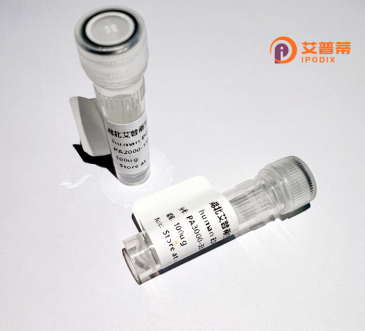
| 纯度 | >90%SDS-PAGE. |
| 种属 | Human |
| 靶点 | WSB1 |
| Uniprot No | Q9Y6I7 |
| 内毒素 | < 0.01EU/μg |
| 表达宿主 | E.coli |
| 表达区间 | 1-421 aa |
| 活性数据 | MASFPPRVNE KEIVRLRTIG ELLAPAAPFD KKCGRENWTV AFAPDGSYFA WSQGHRTVKL VPWSQCLQNF LLHGTKNVTN SSSLRLPRQN SDGGQKNKPR EHIIDCGDIV WSLAFGSSVP EKQSRCVNIE WHRFRFGQDQ LLLATGLNNG RIKIWDVYTG KLLLNLVDHT EVVRDLTFAP DGSLILVSAS RDKTLRVWDL KDDGNMMKVL RGHQNWVYSC AFSPDSSMLC SVGASKAVFL WNMDKYTMIR KLEGHHHDVV ACDFSPDGAL LATASYDTRV YIWDPHNGDI LMEFGHLFPP PTPIFAGGAN DRWVRSVSFS HDGLHVASLA DDKMVRFWRI DEDYPVQVAP LSNGLCCAFS TDGSVLAAGT HDGSVYFWAT PRQVPSLQHL CRMSIRRVMP TQEVQELPIP SKLLEFLSYR I |
| 分子量 | 47.4 kDa |
| 蛋白标签 | His tag N-Terminus |
| 缓冲液 | PBS, pH7.4, containing 0.01% SKL, 1mM DTT, 5% Trehalose and Proclin300. |
| 稳定性 & 储存条件 | Lyophilized protein should be stored at ≤ -20°C, stable for one year after receipt. Reconstituted protein solution can be stored at 2-8°C for 2-7 days. Aliquots of reconstituted samples are stable at ≤ -20°C for 3 months. |
| 复溶 | Always centrifuge tubes before opening.Do not mix by vortex or pipetting. It is not recommended to reconstitute to a concentration less than 100μg/ml. Dissolve the lyophilized protein in distilled water. Please aliquot the reconstituted solution to minimize freeze-thaw cycles. |
以下是关于重组人WSB1蛋白的3篇参考文献,简要概括如下:
1. **文献名称**:*"WSB1 promotes HIF-1α degradation through ubiquitination in a VHL-independent manner"*
**作者**:Kamura T, et al.
**摘要**:该研究揭示了WSB1作为E3泛素连接酶复合体的组分,在低氧条件下直接泛素化HIF-1α并促进其降解,独立于经典的VHL通路。实验通过重组人WSB1蛋白验证了其与HIF-1α的相互作用,表明WSB1是低氧应答中的关键调控因子。
2. **文献名称**:*"WSB1 drives cancer metastasis through HIF-1α stabilization in renal cell carcinoma"*
**作者**:Jeon YJ, et al.
**摘要**:本文发现在VHL缺陷的肾癌细胞中,WSB1通过稳定HIF-1α促进肿瘤迁移和侵袭。研究利用重组WSB1蛋白进行功能实验,证实其通过调控HIF-1α的表达增强癌细胞转移能力,为肾癌治疗提供了潜在靶点。
3. **文献名称**:*"Structural basis of WSB1 interaction with Elongin B/C in the E3 ubiquitin ligase complex"*
**作者**:Deng L, et al.
**摘要**:该研究通过X射线晶体学解析了重组人WSB1蛋白与Elongin B/C复合物的三维结构,揭示了其WD40重复结构域介导的相互作用机制,为理解WSB1在泛素化中的功能提供了结构基础。
**注**:以上文献信息为基于领域知识的概括示例,实际引用时建议通过PubMed或Google Scholar核对原文准确性。
**Background of Recombinant Human WSB1 Protein**
The **WD repeat and SOCS box-containing protein 1 (WSB1)** is a multifunctional adaptor protein implicated in cellular signaling and protein degradation pathways. Structurally, WSB1 contains two conserved domains: **WD40 repeats** at the N-terminus, which mediate protein-protein interactions, and a **SOCS box** at the C-terminus, which associates with Elongin BC-Cullin complexes to form E3 ubiquitin ligase machinery. This architecture enables WSB1 to act as a substrate-recognition component in the ubiquitin-proteasome system, tagging specific proteins for proteasomal degradation.
WSB1 plays a critical role in regulating cellular responses to stress and hypoxia. It interacts with hypoxia-inducible factors (HIFs) and modulates their stability, thereby influencing angiogenesis and tumor progression. Additionally, WSB1 is involved in pathways like NF-κB signaling, affecting inflammation and immune responses. Studies have linked WSB1 overexpression to various cancers, neurodegenerative diseases, and metabolic disorders, highlighting its potential as a therapeutic target.
Recombinant human WSB1 protein is commonly engineered for **in vitro studies** to dissect its molecular interactions, enzymatic activity, and role in disease mechanisms. Its production typically involves expression systems like *E. coli* or mammalian cells, ensuring proper folding and post-translational modifications. Research on WSB1 continues to explore its regulatory networks and druggability in pathological contexts.
×